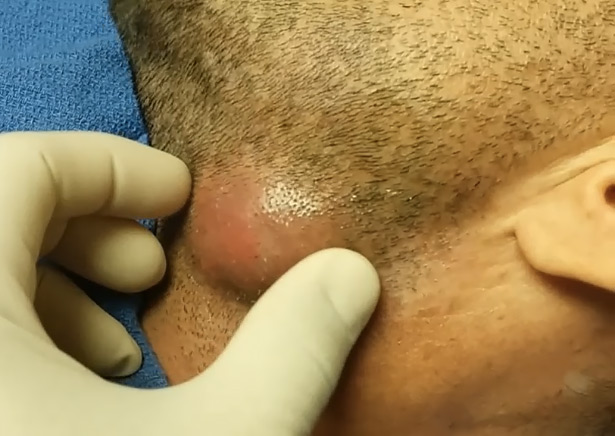A 38 year old male presents from jail with the following pathology. Which nerve block will facilitate drainage?

Answer: Superficial cervical plexus (SCP) block
- The SCP arises from the anterior rami of C1-4 spinal nerves, and innervates the skin and
 superficial structures around the anterior and lateral neck, as well as parts of the shoulder, the clavicle and the ear.1
superficial structures around the anterior and lateral neck, as well as parts of the shoulder, the clavicle and the ear.1 - Case reports have shown this block to be beneficial for posterior ear lacerations, lacerations to the anterolateral neck, submandibular abscesses, central line placement and clavicular fractures.1-4
- To perform the procedure, first identify pertinent landmarks. The area of entry will be at the posterior border of the sternocleidomastoid (SCM) muscle, halfway between the clavicle and the mastoid bone. Marking this area with a sterile surgical pen after cleaning the area with clorhexidine will be beneficial
 After the appropriate landmarks are located, place a sterile tegaderm over the ultrasound transducer and after placing some sterile ultrasound gel on the transducer, place the probe in the marked area. Locate the posterior border of the SCM, which is just superficial to the levator scapulae muscle (LSM).
After the appropriate landmarks are located, place a sterile tegaderm over the ultrasound transducer and after placing some sterile ultrasound gel on the transducer, place the probe in the marked area. Locate the posterior border of the SCM, which is just superficial to the levator scapulae muscle (LSM).- Between 3 and 15 mL of local anesthetic can injected in the facial plane between the two muscles with a 25 gauge needle between the posterior border of the SCM and the LSM.1

- Although serious adverse events have not been reported for ultrasound guidance, there is a potential for injury to the external jugular vein or carotid artery if careful attention to avoid losing sight of the needle tip is not performed.1
- Placing the anesthetic too deep or using excessive anesthetic can also affect surrounding nerves, such as the phrenic nerve, recurrent laryngeal nerve, brachial plexus or deep cervical plexus.1
- For a full video tutorial on how to perform this block, check out 5minsono.
- Herring AA, Stone MB, Frenkel O, Chipman A, Nagdev AD. The ultrasound-guided superficial cervical plexus block for anesthesia and analgesia in emergency care settings. Am J Emerg Med. 2012;30:(7)1263-7. [pubmed]
- de Ramos EBA. Efficacy of anesthetic blockage of superficial branches of the cervical plexus. Int J Odontostomat 2008;2(1):77-81.
- Shteif M, Lesmes D, Hartman G, Ruffino S, Laster Z. The use of the superficial cervical plexus block in the drainage of submandibular and submental abscesses–an alternative for general anesthesia. J Oral Maxillofac Surg. 2008;66:(12)2642-5. [pubmed]
- Ciftci T, Daskaya H, Yıldırım MB, Söylemez H. A minimally painful, comfortable, and safe technique for hemodialysis catheter placement in children: superficial cervical plexus block. Hemodial Int. 2014;18:(3)700-4. [pubmed]




